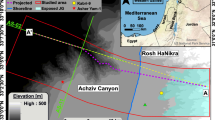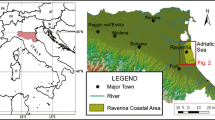Abstract
Coastal reservoirs can alleviate freshwater shortages occurring in the nearshore zone. Deep pools patched at the bottom of reservoirs at greater depths than their adjacent beds maintain a high salinity and possibly provide preferential paths for saltwater backfill. However, such processes are not well understood. Laboratory experiments and numerical simulations were conducted to investigate the effect of the deep pool on subsurface flow and the salinization of coastal reservoir and adjacent aquifers. When seawater intruded into the initially fresh aquifer, the deep pool accelerated the uptake of saltwater to the reservoir from the salt wedge, forming a temporary salt plume around the pool. The saltwater plume also accelerated salt ingress and the evolution of the total salt mass in the coastal reservoir, resulting in the earlier attainment of a quasi-steady state (a classical saltwater wedge) than that when the deep pool was absent. Under steady-state conditions, the deep pool greatly enhanced the exchange of water across the reservoir-aquifer interface by 107% and raised the salinization level of the coastal reservoir by at least 10.3%. Sensitivity analysis suggested that a deeper pool and/or a pool located closer to the reservoir dam may enhance the water exchange and salinity level in the reservoir because it accelerates the water/salt inflow to the freshwater body to a greater extent. These findings may further contribute to improving the predictability and management of water quality in these coastal facilities.










Similar content being viewed by others
Data Availability
The code for this model is available at (Voss and Provost 2002). Figures and data of the experimental and numerical simulations are available.
References
Atlabachew A, Shu L, Wu P, Zhang Y, Xu Y (2018) Numerical modeling of solute transport in a sand tank physical model under varying hydraulic gradient and hydrological stresses. Hydrogeol J 26(6):2089–2113. https://doi.org/10.1007/s10040-018-1758-6
Carsel RF, Parrish RS (1988) Developing joint probability distributions of soil water retention characteristics. Water Resour Res 24(5):755–769. https://doi.org/10.1029/WR024i005p00755
Chui TFM, Freyberg DL (2008) Simulating a Lake as a high-conductivity variably saturated porous medium. Groundwater 46(5):688–694. https://doi.org/10.1111/j.1745-6584.2008.00463.x
Dai P, Zhang J-s, Zheng J-h, Hulsbergen K, van Banning G (2018) Numerical study of hydrodynamic mechanism of dynamic tidal power. Water Sci Eng 11(3):220–228. https://doi.org/10.1016/j.wse.2018.09.004
Genuchten V (1980) A closed-form equation for predicting the hydraulic conductivity of unsaturated soils 1. Soil Sci Soc Am J 44(5):892–898. https://doi.org/10.2136/sssaj1980.03615995004400050002x
Jin G, Tang H, Gibbes B, Li L, Barry DA (2010) Transport of nonsorbing solutes in a streambed with periodic bedforms. Adv Water Resour 33(11):1402–1416. https://doi.org/10.1016/j.advwatres.2010.09.003
Jin G, Tang H, Li L, Barry D (2011) Hyporheic flow under periodic bed forms influenced by low-density gradients. Geophys Res Lett 38(22). https://doi.org/10.1029/2011GL049694
Jin G, Mo Y, Li M, Tang H, Qi Y, Li L, Barry DA (2019) Desalinization and salinization: a review of major challenges for coastal reservoirs. J Coast Res 35(3):664–672. https://doi.org/10.2112/JCOASTRES-D-18-00067.1
Kolathayar S, Krishnan A, Thallak SG (2021) Appraisal of Thanneermukkom bund as a coastal reservoir in Kuttanad, Kerala. J Appl Water Eng Res 1–12. https://doi.org/10.1080/23249676.2021.1884612
Kuan WK, Jin G, Xin P, Robinson C, Gibbes B, Li L (2012) Tidal influence on seawater intrusion in unconfined coastal aquifers. Water Resour Res 48(2). https://doi.org/10.1029/2011WR010678
Kuan WK, Xin P, Jin G, Robinson CE, Gibbes B, Li L (2019) Combined effect of tides and varying inland groundwater input on flow and salinity distribution in unconfined coastal aquifers. Water Resour Res 55(11):8864–8880. https://doi.org/10.1029/2018WR024492
Lin P, Gong Z (2019) Development review and prospects of coastal reservoirs in China. Yangtze River 50(7):1–8. https://doi.org/10.16232/j.cnki.1001-4179.2019.07.001
Lu C, Chen Y, Zhang C, Luo J (2013) Steady-state freshwater–seawater mixing zone in stratified coastal aquifers. J Hydrol 505:24–34. https://doi.org/10.1016/j.jhydrol.2013.09.017
Mao XZ, Chen FY, Yu QW, Zhu XA (2004) Numerical prediction of water desalinization in a polder reservoir. J Hydraul Eng 35(7):74–89. https://doi.org/10.13243/j.cnki.slxb.2004.07.014
Nam NDG, Akira G, Kazutoshi O, Trung NH, Ngan NVC (2019) Assessment of groundwater quality and its suitability for domestic and irrigation use in the coastal zone of the Mekong Delta. Water and Power, pp. 173-185, Springer. https://doi.org/10.1007/978-3-319-90400-9_10
Pan GE, Huang LC, Jin LJ, Zhu XA (2004) Study ontechnology of fresh water storage of reservoirs on coastal areas. Water Conserv Plan Des 2:51–55. https://doi.org/10.3969/j.issn.1672-2469.2004.02.014
Robinson C, Gibbes B, Li L (2006) Driving mechanisms for groundwater flow and salt transport in a subterranean estuary. Geophys Res Lett 33(3). https://doi.org/10.1029/2005GL025247
Robinson C, Li L, Barry D (2007) Effect of tidal forcing on a subterranean estuary. Adv Water Resour 30(4):851–865. https://doi.org/10.1016/j.advwatres.2006.07.006
Sawyer AH, David CH, Famiglietti JS (2016) Continental patterns of submarine groundwater discharge reveal coastal vulnerabilities. Science 353(6300):705–707. https://doi.org/10.1126/science.aag1058
Shen C, Jin G, Xin P, Kong J, Li L (2015) Effects of salinity variations on pore water flow in salt marshes. Water Resour Res 51(6):4301–4319. https://doi.org/10.1002/2015WR016911
Shen Y, Xin P, Yu X (2020) Combined effect of cutoff wall and tides on groundwater flow and salinity distribution in coastal unconfined aquifers. J Hydrol 581:124444. https://doi.org/10.1016/j.jhydrol.2019.124444
Skjetne E, Auriault J-L (1999) High-velocity laminar and turbulent flow in porous media. Transp Porous Media 36(2):131–147. https://doi.org/10.1023/A:1006582211517
Stieglitz T (2005) Submarine groundwater discharge into the near-shore zone of the great barrier reef, Australia. Mar Pollut Bull 51(1–4):51–59. https://doi.org/10.1016/j.marpolbul.2004.10.055
Sugimoto R, Honda H, Kobayashi S, Takao Y, Tahara D, Tominaga O, Taniguchi M (2016) Seasonal changes in submarine groundwater discharge and associated nutrient transport into a tideless semi-enclosed embayment (Obama Bay, Japan). Estuar Coasts 39(1):13–26. https://doi.org/10.1007/s12237-015-9986-7
Sun B, Liu S, Gu J, Kuang C, Yu W (2008) Numerical study on impact of water regulation of TGP and south-to-north water diversion project on water source area of the Yangtze estuary. Yangtze River 39(16):4–6. https://doi.org/10.16232/j.cnki.1001-4179.2008.16.009
Voss CI, AM Provost (2002) SUTRA, a model for saturated-unsaturated, variable-density ground-water flow with solute or energy transport. U.S. Geol. Surv. Water Res. Invest. Rep., 02-4231
Voss CI, Souza WR (1987) Variable density flow and solute transport simulation of regional aquifers containing a narrow freshwater-saltwater transition zone. Water Resour Res 23(10):1851–1866. https://doi.org/10.1029/WR023i010p01851
Vu D, Yamada T, Ishidaira H (2018) Assessing the impact of sea level rise due to climate change on seawater intrusion in Mekong Delta, Vietnam. Water Sci Technol 77(6):1632–1639. https://doi.org/10.2166/wst.2018.038
Wang LQ, Zhu M (2014) Seawater intrusion in the eastern coastal area of Changli county and the prevention measures. J Hebei Eng Tech Coll 03:30–32. https://doi.org/10.16046/j.cnki.issn1008-3782.2014.03.038
Werner AD, Bakker M, Post VE, Vandenbohede A, Lu C, Ataie-Ashtiani B, Simmons CT, Barry DA (2013) Seawater intrusion processes, investigation and management: recent advances and future challenges. Adv Water Resour 51:3–26. https://doi.org/10.1016/j.advwatres.2012.03.004
White J, Roberts T (1994) The significance of groundwater tidal fluctuations. In: Wilkinson WB (ed) Groundwater Problems in Urban Areas: Proceeding of the International Conference Organized by the Institution of Civil Engineers and Held in London, 2–3 June 1993. Thomas Telford, London, pp 31–42
Winter TC (1976) Numerical simulation analysis of the interaction of lakes and ground water. US Geological Survey, Washington, DC, pp 1–45
Yang SQ (2018) Water resources management (pp. 121-139). Springer
Zhang XS, Wang JX, Wong H, Leo CJ, Liu Q, Tang YQ, Yan XL, Sun WH, Huang ZQ, Hao XH (2013) Land subsidence caused by internal soil erosion owing to pumping confined aquifer groundwater during the deep foundation construction in Shanghai. Nat Hazards 69(1):473–489. https://doi.org/10.1007/s11069-013-0718-7
Zhu J (2002) Analysis on the causes of salty water quality in Huchengang reservoir and its control measures. Zhejiang Water Conserv Sci Technol 4:50–51. https://doi.org/10.13641/j.cnki.33-1162/tv.2002.04.023
Funding
This research was supported by the Natural Science Foundation of China (51479069), Social Development - Major Demonstration of Science and Technology of Science and Technology Projects of Jiangsu Province (BE2018737), National Key Research and Development Program of China (2016YFC0402605), the China Scholarship Council, the 111 Project (B17015), Ministry of Education, and the State Administration of Foreign Experts Affairs, P. R. China.
Author information
Authors and Affiliations
Contributions
Conceptualization: [Yuming Mo, Guangqiu Jin, Chenming Zhang, Chengji Shen, Ling Li]; Methodology: [Yuming Mo, Guangqiu Jin, Chenming Zhang]; Formal analysis and investigation: [Yuming Mo, Guangqiu Jin, Ling Li]; Writing - original draft preparation: [Yuming Mo, Jing Xu]; Writing - review and editing: [Yuming Mo, Guangqiu Jin, Chenming Zhang, Alexander Scheuermann]; and Supervision: [Guangqiu Jin, Hongwu Tang, Ling Li].
Corresponding author
Ethics declarations
Conflict of Interest
The authors declare that they have no conflicts of interest.
Consent to Participate
Not applicable.
Consent to Publish
All the authors have approved the submission and consented for publication.
Additional information
Publisher’s Note
Springer Nature remains neutral with regard to jurisdictional claims in published maps and institutional affiliations.
Submitted to Water Resources Management on 14 January 2021, revised on 15 May 2021
Rights and permissions
About this article
Cite this article
Mo, Y., Jin, G., Zhang, C. et al. Effects of the Deep Pool on Groundwater Flow and Salinization in Coastal Reservoir and Adjacent Aquifer. Water Resour Manage 35, 2667–2684 (2021). https://doi.org/10.1007/s11269-021-02858-8
Received:
Accepted:
Published:
Issue Date:
DOI: https://doi.org/10.1007/s11269-021-02858-8




